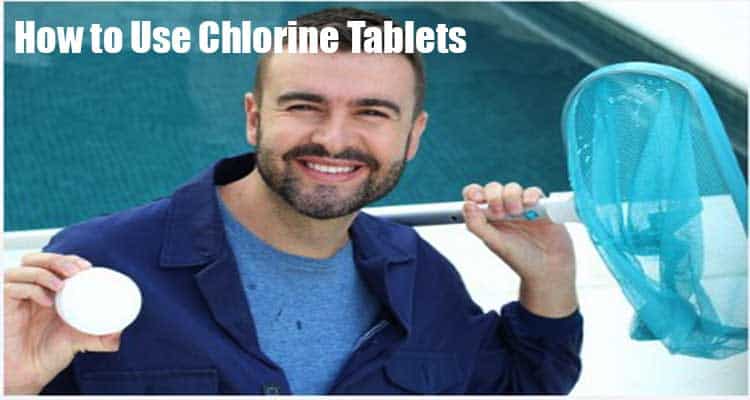Using chlorine tablets is the best way to sanitize and disinfect your pool to get rid of the bacteria. This type of sanitizer continues to become popular, as some portable pool manufacturers have chosen to recommend it to customers. Because of the increase in popularity of portable pools, the demand for chlorine tablets also increases. We have written this how-to-use chlorine tablets guide to help you keep your pool clean and safe to swim in.
Different Ways of Adding Chlorine Tablets

Chlorine tablets are available in one inch and three inches. The most commonly used size is the 3-inch chlorine tablets, as one table can treat around 5,000 gallons of water. One-inch tablets contain less chlorine which makes them ideal for spas and smaller indoor pools.
The number of tablets to be used will depend on how big the pool to be treated is. Below is a guide that includes the number of chlorine tablets needed:
| Size of Pool (gallon pool) | Number of Chlorine Tablets |
| 2500 to 5000 | 1 Chlorine tab per week |
| 7000 | 1 to 2 tablets per week |
| 10,000 | 2 Chlorine tablets per week |
| 13,500 | 2 to 3 Chlorine tablets per week |
| 15,000 to 17,000 | 3 Chlorine tablets per week |
| 20,000 | 3 to 4 Chlorine tablets per week |
| 25,000 | 4 to 5 Chlorine tablets per week |
| 30,000 | 5 to 6 Chlorine tablets per week |
To keep things simple, a single 3-inch tablet can disinfect up to 5,000 gallons of water. That equates to four tablets sanitizing a 20,000-gallon pool.
Some pool owners might be asking why not just throw chlorine tablets in the water. Chlorine tablets are intended to be dissolved in water. But, they are not designed to dissolve on the pool floor.
Leaving chlorine pills on the pool’s bottom might result in permanent discoloration and bleaching of the liners. It’s also the least efficient way to employ them.
Tablets at the bottom of your pool are nowhere near the skimmer line. As a result, they break down more slowly and release sanitizer unevenly. When you use chlorine pills in this manner, most of the chlorine is squandered, requiring you to use even more. Instead, here are four much better ways to add chlorine tablets to your swimming pool.
Floating Dispenser
Floating dispensers are small plastic containers you usually see on top of the water surface. Sometimes they have a strange duck or animal on top, and other times they are blue. The simplicity of floating dispensers is what makes them so appealing. They only retain a few tablets and keep them safely trapped until they dissolve gradually. The dispenser delivers chlorine into the water as it floats around the surface of your pool.
However, floating dispensers are not without flaws. They can become stuck in one place or become imprisoned in a corner at times. Furthermore, because they are fully manual, they do not float in a specific pattern, which means they do not always disperse chlorine evenly.
Skimmer
The skimmer in your pool is intended to keep loose surface detritus like leaves and bugs out. It’s also perfect for administering chlorine. Water floats into your skimmer line, past the pump, through the filter, through the heater, and back into the pool as your pool pump works.
With a continual flow of water going through it, your skimmer is the ideal location to disperse and dissolve the chlorine from your pills. It also distributes chlorine equally to a dispenser because it is directly in the direction of your water flow. However, tablets left in your skimmer will continue to dissolve even if your pump is turned off.
If the tablets are left to rest for a few days, they can generate a very concentrated, chlorinated water zone, damaging pool equipment, and pipelines. The easiest way to avoid this is to schedule your pump or remove tablets once they’re mostly dissolved. If you have a single-speed pump, switching to a variable-speed pump can reduce your energy expenditure and allow you to keep your filter running on a budget.
Automatic Chlorinator
If you’re going to use chlorine tablets, an automatic chlorinator is the best way to go. This specialized piece of equipment allows you to manage how much chlorine is added to your water precisely. It also lets you choose how quickly or slowly your tablets dissolve.
It’s just a large container you fill with chlorine pills and has a knob for controlling the flow rate. They are often put at the very end of your pool system, just after the heater and before the return line.
Load up an automatic chlorinator, regulate the flow rate, and enjoy clean water. It saves you the time it would take to add new tablets each week. Furthermore, you get the greatest bang for your buck with direct control over the chlorine input rate.
Crushing the Tablets
Another way to add the chlorine tablets to the water is by crushing them. If you want to chlorinate your pool but are short on time, crushing a few tablets into a fine powder and scattering them over the pool is the best option. While the chlorine will not stay long using this method, it will work more quickly, making it ideal for last-minute water sanitization.
Frequently Asked Questions – (FAQ)
a) How many chlorine tablets should you use?
The number of chlorine tablets you need to use will depend on your pool’s water capacity. It may vary from 1 to 10 tablets. Refer to the table above for the number of chlorine tablets you need to add.
b) Can I use chlorine tablets without a pump
Yes, you can use chlorine tabs without a pump. As mentioned above, you can use a skimmer, floating dispenser, chlorinator, and crushing the tablets. Most pool owners would use a chlorinator as it will automatically disperse the chlorine in your pool depending on the setting you set on the unit.
c) How long after adding chlorine tablets can you swim?
When you add calcium chloride to your pool, you should wait 2-4 hours (or one complete cycle through the filter) before swimming. Swimming is safe until your chlorine levels have dropped to roughly 5 parts per million (ppm) or after 24 hours. It’s always best to test the water first.
d) Where do you put chlorine tablets in the Intex pool?
After you’ve balanced all of your other chemicals, the next step is to handle the pool’s sanitizing requirements. Most pool owners rely on the tried-and-true chlorine bleach method. But that isn’t the only technique to chlorinate your water.
An Intex saltwater pool system is the most effective technique to chlorinate an Intex pool. Because it does all of the work for you, it creates chlorine on its own. It adds chlorine to your water as needed. And it keeps doing it.
Furthermore, the chlorine produced by saltwater pool systems is often less toxic than traditional chlorine bleach. This is because saltwater chlorination systems only employ, well, salt to make chlorine. As a result of using fewer chemicals, chlorine is “cleaner” and gentler.
If a saltwater system isn’t a possibility right now, you still have the above options.
Conclusion
The above options on how to use chlorine tablets are the best and safest ways to chlorinate the pool water. To summarize, you only need 2-4 every week, and utilizing them is as simple as adding them to your skimmer. Your pool pump will then handle the rest of the job for you.
Of course, remember to purchase the appropriate tablets for the size and configuration of your pool. In general, three-inch stabilized chlorine pills are recommended for outdoor use, whereas 1-inch unstabilized tablets are suitable for small indoor pools. You can comment below if you want to share your thoughts and if you have questions.
